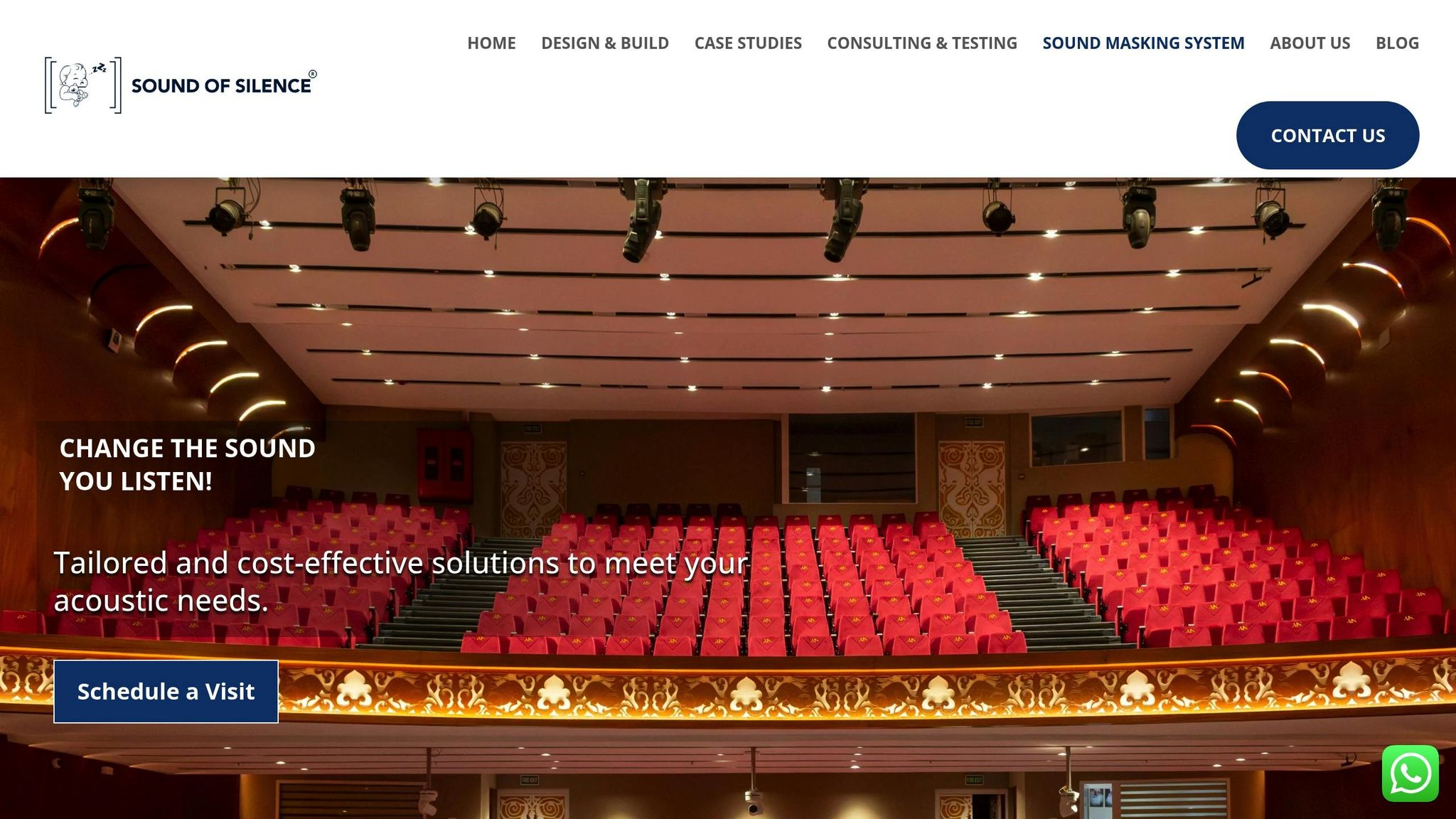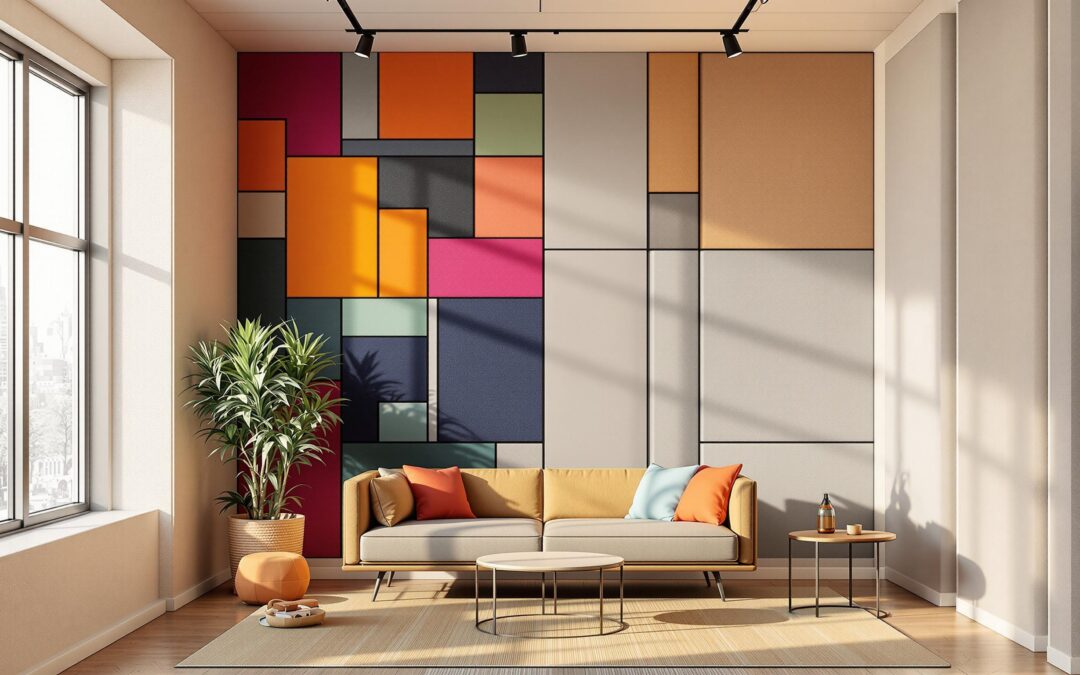Looking to improve sound in your space? Here’s a quick guide to help you decide between acoustic panels and sound absorption panels:
- Acoustic panels: Best for reducing echoes and improving sound clarity in large spaces (e.g., theatres, conference rooms). Made with dense materials like fibreglass or wood, they absorb mid-range frequencies crucial for speech clarity.
- Sound absorption panels: Ideal for reducing noise and echo in smaller rooms (e.g., studios, classrooms). Constructed with open-cell foam, they work well for higher frequencies, such as musical or mechanical sounds.
Quick Comparison
| Feature | Acoustic Panels | Sound Absorption Panels |
|---|---|---|
| Core Material | Fibreglass, mineral wool, or wood | Open-cell foam |
| Frequency Control | Mid-range (speech clarity) | High frequencies (music, noise) |
| Applications | Large spaces (theatres, venues) | Small rooms (studios, offices) |
| Aesthetics | Customisable, fabric-wrapped | Practical, foam finish |
| Cost | Higher | More affordable |
Key Tip:
Choose acoustic panels for larger spaces needing clear sound. Opt for sound absorption panels if you’re managing noise or echo in smaller rooms.
Types of Sound Panels Explained
How Acoustic Panels Work
Acoustic panels are built using multiple layers. At their core, you’ll typically find dense materials like fibreglass, mineral wool, or wood, all wrapped in a fabric covering. The core often has a density of about 6 pounds per cubic foot (pcf), which helps absorb and scatter sound effectively[4].
When sound waves hit these panels, the dense core absorbs the energy and turns it into a small amount of heat through friction. This process works particularly well for mid-range frequencies, which are essential for clear speech. Adding an air gap between the panel and the wall can improve their Noise Reduction Coefficient (NRC), sometimes even doubling it[1]. This approach is different from how sound absorption panels function.
How Sound Absorption Panels Work
Sound absorption panels use open-cell foam to catch and reduce sound energy. The thickness of the foam plays a key role in determining how well it works across various frequencies. For example, foam that’s 2 inches thick is effective for frequencies above 2–3 kHz, while 4-inch thick foam can handle frequencies as low as 1 kHz[2].
These panels are particularly good at managing higher frequencies, making them ideal for spaces with mechanical noise or musical activities. The open-cell structure allows sound waves to travel deeper into the material, where they lose energy through repeated internal reflections[5].
Main Differences
Here’s a quick comparison of the two types of panels:
| Feature | Acoustic Panels | Sound Absorption Panels |
|---|---|---|
| Core Material | Dense materials (fibreglass, mineral wool, wood) | Open-cell foam |
| Frequency Control | Mid-range sounds, ideal for speech clarity | Higher frequencies, suited for musical environments |
| Physical Structure | Multi-layered with fabric covering | Single-piece foam construction |
| Typical Applications | Larger public spaces (theatres, conference rooms) | Smaller private rooms (recording studios, equipment enclosures) |
| Aesthetics | Clean edges, customisable fabric finishes | More practical appearance |
| Cost Consideration | Generally more expensive | Budget-friendly |
Sound absorption panels are a better fit for smaller spaces where controlling high-frequency noise is a priority. The right choice between these two depends on the specific acoustic needs of your space.
Where to Use Each Panel Type
Best Spaces for Acoustic Panels
Acoustic panels work well in spaces like theatres, conference rooms, and concert venues to improve sound clarity. Recording studios also benefit, as these panels absorb high and mid frequencies, creating a clean and controlled sound environment[3][6].
Best Spaces for Sound Absorption Panels
Sound absorption panels are ideal for large, open spaces with reflective surfaces and high ceilings. These panels help control echo and reverberation. For example, lecture halls and classrooms need a reverberation time of less than 0.6 seconds to ensure clear communication and effective learning[7].
| Surface Material | Noise Reduction Coefficient (NRC) |
|---|---|
| Glass and Tile | 0.00 (100% reflection) |
| Hardwood/Drywall | 0.15 (15% absorption) |
| Carpeting/Ceiling Tiles | 0.40–0.60 |
| Wood Acoustic Panels | 0.85+ |
This table highlights how different materials perform when it comes to sound absorption.
Sound of Silence Success Stories

Sound of Silence has successfully improved acoustics in a variety of spaces, including heritage buildings and restaurants. Their work in heritage structures stands out, as it balances maintaining architectural features with enhancing sound quality.
"Sound Absorbing Panels can be an excellent option when you have excessive reverberation or echo within a closed space…making speech more intelligible, and improving acoustical comfort."[7]
To achieve the best results, Sound of Silence advises:
- Treating parallel walls to eliminate standing waves[7].
- Placing panels directly opposite the main sound sources[1].
For restaurants, their approach varies depending on the setting. Fine dining spaces typically require more detailed treatment than casual eateries, ensuring the acoustic environment matches the desired atmosphere[7].
How to Choose the Right Panels
Space Requirements
The size and purpose of your room play a big role in selecting the right panels. For rooms larger than 50 m², consider acoustic panels in bigger sizes (up to 1.2 x 3 metres). These are particularly effective at managing mid-range frequencies[2]. On the other hand, smaller rooms under 30 m² – like home studios or private music spaces – benefit from sound absorption panels. These panels are available in smaller sizes, typically between 0.3 x 0.3 metres and 1.2 x 2.4 metres, making installation in tight spaces much easier[2].
| Room Type | Size Range | Recommended Panel |
|---|---|---|
| Large Public Venues | >50 m² | Acoustic Panels |
| Medium Spaces | 30–50 m² | Mixed Solution |
| Small Private Rooms | <30 m² | Sound Absorption Panels |
Sound Goals
The purpose of the space determines the type of panel you need. For places where clear speech is critical – like lecture halls or conference rooms – acoustic panels are ideal, as they manage mid-range frequencies that impact voice clarity[2]. In contrast, spaces like recording studios or practice rooms, where high-frequency sounds dominate, perform better with sound absorption panels.
Budget and Room Conditions
Your budget and the room’s environment are key factors in panel selection. While acoustic panels may cost more upfront, they’re built to last and often add a polished look to the space. These panels typically feature a dense core of wood or fibreglass, covered with fabric that combines functionality with style[2].
Room conditions also matter. In areas with high humidity or fluctuating temperatures, moisture-resistant panels are a smart choice. For spaces like sports facilities that need frequent cleaning or must withstand heavy use, durable acoustic panels provide better long-term value[8].
For heritage buildings or rooms with limited wall space, ceiling-mounted panels can be a practical solution. For instance, St Andrew’s Church hall used acoustic ceiling baffles to maintain wall space while achieving effective sound control[8]. Next, explore how to install and maintain your panels.
sbb-itb-06ab728
Panel Setup and Care Guide
Installation Steps
Set up panels at ear or microphone height (1.2–1.5 metres) on walls that have been cleaned with a mix of 50% vinegar and 50% water. This ensures better adhesion.
For professional installations, there are three main mounting options:
| Mounting Method | Best For | Benefits |
|---|---|---|
| Impaling Clips | Permanent setups | Strong hold with a polished look |
| Z-Clips | Removable panels | Easy to take down with minimal wall damage |
| Wire Hanging | Ceiling setups | Adjustable and versatile positioning |
If you’re using impaling clips, place them about 10 centimetres inside the marked area. Secure the clips with suitable wall fixings, then apply construction adhesive near each clip before pressing the panel into place firmly [9].
"Although hanging acoustic panels is not rocket science, it does require a little thought and planning." – Terry Schutz [9]
Once installed, proper maintenance will help keep your panels effective over time.
Maintenance Steps
Each panel type needs a specific cleaning routine:
- Fabric-Wrapped Panels: Use a vacuum with a soft brush weekly. Quickly blot spills, and for tougher stains, mix 1 teaspoon of laundry detergent with a pint of warm water [10].
- PVC and Vinyl Panels: Clean these monthly with mild soap and warm water. Avoid strong chemicals. For textured vinyl, a hard-bristled brush works best [11].
| Panel Type | Cleaning Frequency | Tools Needed |
|---|---|---|
| Fabric-Wrapped | Weekly | Vacuum, lint-free cloth |
| PVC Encapsulated | Monthly | Soft sponge, mild soap |
| Vinyl | Monthly | Hard-bristled brush, mild detergent |
When to Replace Panels
Keep an eye out for these signs that your panels may need replacing:
- Physical Damage: Tears, fraying fabric, dents that don’t bounce back, or water stains.
- Performance Issues: More echo or reverberation, reduced sound clarity, or sagging and warping.
Inspect your panels every six months to catch any problems early.
Acoustic Foam vs. Acoustic Panels – Is There Any Difference?
Contact Sound of Silence for Help
Not sure which acoustic panel is right for your space? The team at Sound of Silence has handled over 5,000 installations in settings ranging from bustling restaurants to professional recording studios.
With a free consultation, we’ll help you find the perfect solution by considering:
- Space dimensions and layout
- Current acoustic challenges
- Desired sound quality goals
- Budget requirements
- Aesthetic preferences
| Space Type | Common Issues | Recommended Assessment |
|---|---|---|
| Restaurants & Cafes | Echo and background noise | On-site dB measurement |
| Offices & Boardrooms | Speech clarity, video call issues | Acoustic design consultation |
| Recording Spaces | Sound reflection, external noise | Comprehensive sound testing |
We’ve got the results to back it up. For example, New Coast Kitchen in Croyde Bay, Devon, installed Solo Squares in their restaurant and saw a huge improvement in reducing echo. Customers even praised the improved noise control. Another success story comes from Alexandra James, Executive Assistant at Fearless Adventures. She shared how Solo Circle 1200mm acoustic panels completely eliminated echo in their boardroom, making video calls clearer. She also appreciated how easy the panels were to install and described the service as outstanding.
Ready to transform your space? Reach out to schedule a consultation. You can email your project details, chat with our specialists, or call us for immediate support. Our experts will evaluate your needs and recommend the best panel combination for effective sound control.

